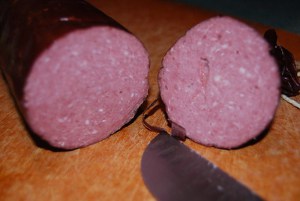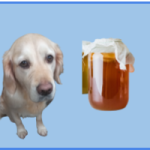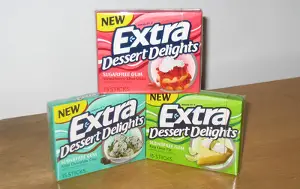
A lot of meat-loving dog owners want to know whether summer sausage is a good food for their favourite pets to snack on or whether it is a food that should be avoided at all costs.
And then there are those dog owners who are asking about this, not because they want to feed it to their dog as an occasional treat, but because their dog has just stolen a summer sausage from the kitchen counter and eaten it in one sitting.
After all, all your dog needs is a whiff of the smell of the sausages and poof! It’s gone, leaving you with just a broken plate.
And the aim of this article is to find out whether you will be faced with a large vets bill as well.
To start with, let’s find out exactly what a summer sausage is.
What are summer sausages?
Summer sausage is a fermented sausage made with a blend of beef and pork meat; semi-dried, it loses about 15% of its moisture during preparation. There are two types—the regular summer sausage made with pork and beef, and the beef sausage made with beef alone.
The great thing about summer sausage lies in the fact that it can keep its freshness, if not opened, for a long time without being refrigerated. Initially, it used to be prepared during the winter to eat during the summer, hence its name.
This doesn’t necessarily mean that the summer sausage shouldn’t be refrigerated at all. Refrigeration increases its shelf life as it for up to 6 months if kept in the fridge. The summer sausage is only suitable for three weeks if opened.
Is summer sausage a healthy food?
Summer sausage belongs to the class of junk foods. They are high in fats and include many additives and preservatives, which pose a significant risk to you and your dog’s health. So except you are making it yourself, I suggest you keep its intake to the barest minimum.
100g of summer sausage contains about 26g of sodium. That is, for every summer sausage your dog eats, he eats about 26% of fat, a significant obesity risk. The high sodium contents found in them (about 1175mg per 100g) are also a significant health hazard to your dog as they can cause kidney and heart cancer.
Summer sausage also has some levels of protein in it (about 16g), but I’m pretty sure your dog can get by consuming other treats. Summer sausage has little nutritional value to give; that is, it has many downs and too few ups to have it as the leading snack choice when it comes to your dogs.
What are the different ingredients and flavors?
Summer sausage is made by grinding beef and pork at a ratio that varies according to the cook’s preference. After which curing salt, nitrites, garlic or onions and spices are added to the ground meat. These spices vary, but mainly, mustard seed, nutmeg, allspice, black pepper, white pepper and coriander are used. The ground meat is then fermented until a low PH (of about 4.5) is obtained, and then the meat is dried.
These spices added to the summer sausage can be dangerous for your dog as they could cause stomach pains, diarrhea and gas. So imagine the amount of mess you’ll have to endure just by feeding your dog summer sausages; trust me, it doesn’t compare to the amount of pain you will be causing your dog by providing him spicy food.
What flavors or ingredients might be poisonous to dogs?
The dog has a different metabolism from ours. While garlic and onions are safe for us to eat, medicinal even, it is harmful to your dog.
Garlic and onions contain thiosulphate, which reduces your dog’s red blood cell’s ability to carry oxygen as it attaches itself to the oxygen molecules of the red blood cells. Apart from that, your dog’s body also treats the blood cell as an invader and destroys it in a process called hemolysis, causing hemolytic anemia.
Anemia symptoms are decreased appetite, fainting, panting, elevated heart rate, weakness, jaundice, lethargy and reddish urine. Garlic and onions also cause gastrointestinal upsets, which include vomiting, diarrhea, abdominal pain and dehydration.
Even though small doses of garlic and onions may not have a significant effect on your dog, it should also be noted that intake of harmful bits over a few days can also be problematic for them.
The high level of salt content in store-bought summer sausages may also cause mild to severe digestive issues, pancreatitis, kidney damage and salt poisoning in your dogs.
Are summer sausage casings dangerous for dogs?
While deliberating on whether or not you should continue giving your dog summer sausages as a treat, you should also consider how safe the casing would be for your dogs.
Sausage casings are of three main types. We have the natural casings, which are cow and sheep intestines, edible but not often used for summer sausages, the Collagen casings, which are made up of beef protein.
They can both be edible or non-edible, depending on the types. The Fibrous sausage casings, which are made up of plant cellulose, are the most used casings for summer sausages. These casings are not edible.
Unfortunately, your dogs don’t know the difference between edible and inedible as they eat everything they can get their mouths on. Therefore, you should make sure that your sausage casings are well disposed of and away from your dog’s reach.
These casings, if ingested, may wrap around your dog’s intestine, causing complications such as indigestion, vomiting, diarrhea, lethargy and an inability to poop. If this happens, my best advice is that you take a quick trip to your local veterinarian.
How should I prepare summer sausage for my dog?
Summer sausage is not healthy for your dogs to eat. However, suppose you would still like to feed your dogs this meal.
Then i’ll suggest you go for homemade summer sausages as you have control over the beef, the spice, pepper and the quality of meat used for your sausage. Onions and spice should be kept as low as possible, and they should be cut into small chunks for your dogs to eat to avoid choking.
Could small dogs or puppies eat summer sausages?
Small dogs or puppies should not be fed summer sausages as it is a tremendous choking hazard to them.
Not to mention that the rich flavors in the summer sausage would affect the delicate puppies tummies. As it poses a significant risk to adult dogs, it poses a greater risk to your puppies.
What are the best training treats for dogs?
There is a lot of food in your kitchen, which does not pose any health hazard for your dogs. These can be used as training treat instead of store-bought treats.
It’s best if you begin with giving out small portions of new treats to your dogs to see how they react to them before choosing it as a new treat for them.
Kitchen foods considered safe for your dogs are apples, green peas, carrots, green beans, watermelon, spinach, rice, pumpkin, cooked sweet potatoes, bananas, broccoli, cooked squash, peanut butter, strawberries, and blueberries, among all others.
Your dogs can also be given Bananas, strawberries, and blueberries can also be given to as they contain great nutrients and vitamin c. Still, they should be given in moderation as their high sugar content may pose a health hazard to your dogs.
Your dogs can be given these foods as they can be prepared specially for your dogs as treats at home in the form of cakes or biscuits. It is easy to prepare, and indeed, your dog will appreciate you for the extra work.
Can dogs eat summer sausage?
I’m pretty sure that while reading this article, you’ve already had a better idea of whether or not summer sausage is a safe treat to give to your dogs.
But to answer the question, I’ll say yes, but in tiny chunks and doses. If possible, avoid it.
Your dog knows nothing about how to take care of themselves, so it’s up to you to decide what is safe for them.
So next time you’re eating summer sausages, make sure you have a healthy treat with you. So that when your dog wags his tail and tells you,” please give me a bite”, tell him, “no! But I have something better for you”.





